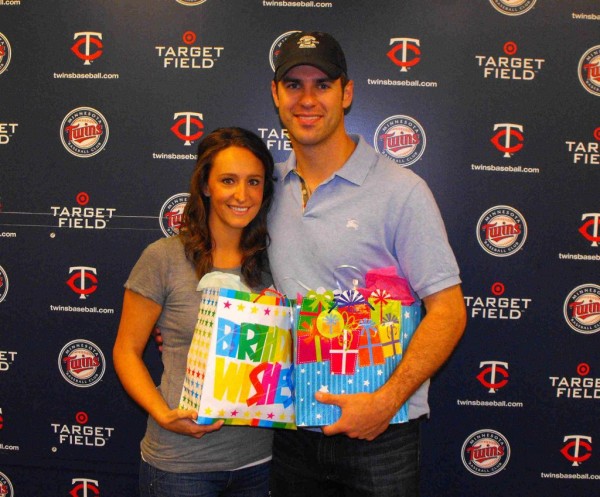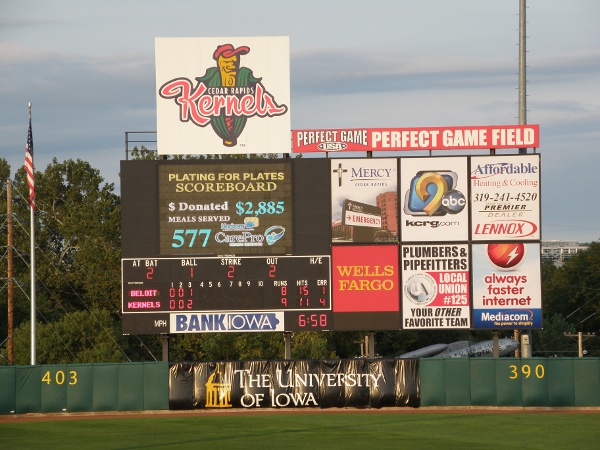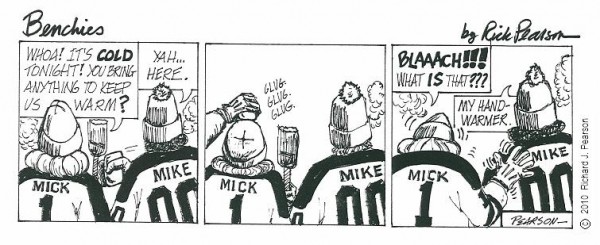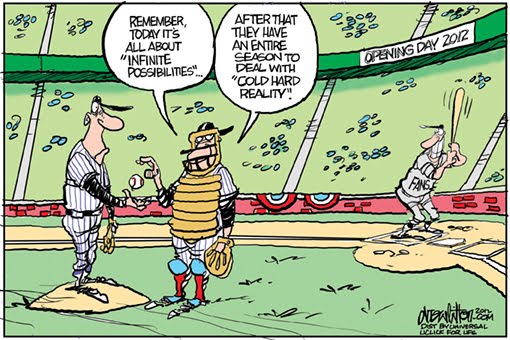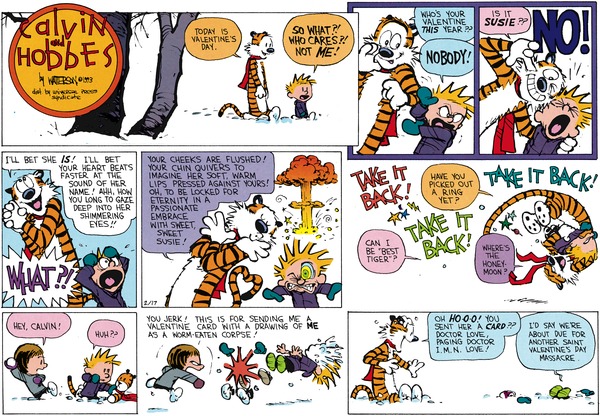It was the best of times, it was the worst of times.
OK, not so much the former, but 2012 certainly would have to be considered among the worst of recent times for the fan bases of both the Minnesota Twins and Cleveland Indians.
 The Tribe lost 94 games in 2012, which was just good enough to allow them to finish two games ahead of the Twins in the final AL Central Division standings. It was a disappointing season after Cleveland came within a couple of games of .500 in 2011. That had given fans some cause for optimism (or at least hope) as it came after a two-year stretch in 2009-2010 in which the Indians lost a total of 190 games.
The Tribe lost 94 games in 2012, which was just good enough to allow them to finish two games ahead of the Twins in the final AL Central Division standings. It was a disappointing season after Cleveland came within a couple of games of .500 in 2011. That had given fans some cause for optimism (or at least hope) as it came after a two-year stretch in 2009-2010 in which the Indians lost a total of 190 games.
So, as the Cleveland brass sat down after last season to plot out their offseason strategy, they faced these stark realities: Their team had lost over 90 games in three of the past four seasons, with only the 82-loss season of 2011 breaking up the string. Attendance at Progressive Field was 29th in Major League Baseball, drawing in just 19,797 fans per game. More fans showed up for Astros games than in Cleveland (not by much, but still). Only the Rays got worse fan support.
In setting their payroll budget over the previous several seasons, Cleveland’s front office had followed a pattern that should sound familiar to Twins fans. After winning the AL Central in 2007 with 96 wins, payroll jumped about 27% heading in to 2008. That season, the Tribe was just a .500 ballclub, but management stayed the course and, in fact, even increased payroll slightly in 2009, when it reached $81,579,166.
But in 2009, Cleveland lost 97 games and attendance dropped by about 18.5%. Of course, conventional small-market (or is that small-minded?) wisdom called for a corresponding slashing of payroll for 2010. In fact, the Indians cut payroll closer to 25%. Despite the payroll cut, the Indians actually improved on the field. Instead of losing 97 games, they only lost 93. Naturally, a second 90+ loss season called for an even greater reduction in payroll (is ANY of this starting to sound familiar to you, Twins fans?) and in 2011, the Tribe opened with a payroll below $50 million.
The 2011 bargain-basement Indians arguably surprised fans on the field, falling just short of reaching the .500 mark. The fans didn’t exactly flock to Progressive Field, but they showed up in enough numbers to result in an attendance increase of over 30% above 2010. That got the front office’s attention and in 2012, they committed to an Opening Day payroll also more than 30% higher than in 2011. As we now know, they were rewarded for their generosity with a 94-loss season, which was witnessed in person by just over 1.6 million Cleveland fans.

You could argue that the Twins are following a similar franchise arc to that which the Indians have been on, just a year or two behind them. Of course, they also have a much newer ballpark (can you believe that 2013 will be the Indians 20th season in their “new” park?!) so the raw dollar amounts they’re dealing with are higher than what the Tribe’s front office has been working with.
But while they may be in slightly different spots on their shared arc, these two organizations found themselves entering this past offseason in very similar positions. They both compete (if you can call 94 and 96 losses “competing”) in one of the weakest divisions in Major League Baseball. Only the Tigers can even be considered anything close to being at the same level as the top teams in other divisions. They were both seeing home attendance sag. Both teams had little for elite prospects ready to bring up and play meaningful Big League roles.
With that in mind, let’s compare the moves the two teams’ front offices have made since the end of last season.
Field Staffs:
Cleveland started making moves even before the end of the 2012 season. On September 27, they fired manager Manny Acta. A couple of weeks later, they made a splash by hiring Terry Francona to manage the team in 2013.
The Twins retained manager Ron Gardenhire, but did not extend his contract beyond the upcoming season. They parted ways with three coaches and reassigned duties of some of the holdovers, while adding Tom Brunansky, Bobby Cuellar and Terry Steinbach.
Player moves:
The first major move by the Twins was to trade highly regarded outfielder Denard Span to the Nationals for highly regarded starting pitching prospect Alex Meyer.
Without Meyer, the Twins’ sole “top 30” prospect this offseason would have been an infielder (3B Miguel Sano) who had not played above Class A yet.
Less than two weeks later, the Indians made their first major move. They participated in a three-team, multi-player trade that saw them saying good-bye to highly regarded outfielder Shin-Soo Choo, in return for highly regarded starting pitching prospect Trevor Bauer (yes, there were other lesser pieces involved, too).
Without Bauer, the tribe’s sole “top 30” prospect this offseason would have been an infielder (SS Francisco Lindor) who had not played above Class A yet.
Both teams had made a clear signal with their initial deals that they were heading toward an offseason of rebuilding for the future. The Twins took that signal to another level by also trading outfielder Ben Revere to the Phillies for pitcher Vance Worley (who won’t be arbitration eligible until 2014) and pitching prospect Trevor May.
Before the end of the year, however, both teams made moves that could arguably be viewed as efforts to pacify their fan bases by showing they weren’t totally giving up on 2013. The Indians signed Mark Reynolds in December, while the Twins inked veteran pitchers Kevin Correia, Mike Pelfrey and Rich Harden before year-end.
Still, as 2013 dawned, it was apparent to most of us that both teams were more interested in setting themselves up to compete a couple of years in the future than in 2013.
Well, we were half right anyway. The Twins front office took a few weeks off, apparently, and made no moves of any significance until signing pitcher Rafael Perez to a minor league contract last week.
The Indians, however, have continued to stay busy… and not just with tweaking their roster around the edges on minor league deals with invitations to Spring Training.
On January 4, they signed Nick Swisher to a four year contract, plus an option, and just for good measure, also inked pitcher Brett Myers to a one year contract.
Over the following couple of weeks, they signed minor league deals with a number of players, such as pitchers Scott Kazmir and Matt Capps.
Then they added pitcher Daisuke Matsuzaka.
Finally, they added outfielder Michael Bourn on another four year contract, plus an option.
In all, Cleveland committed to $117 million of guaranteed money to free agents during the offseason.
One could easily argue that the Indians have done pretty much exactly what many of us hoped the Twins would do… make some trades and free agent signings that would make them stronger immediately AND add a pitching prospect that has the potential to grow in to someone that could head a rotation in the future.
As these two teams prepare for 2013 to open, the Twins have the deeper minor league organization, while the Indians have done more to improve the product on their Major League field in 2013.
As a Cedar Rapids Kernels fan, I’m thrilled with the depth of the Twins’ farm system right now. However, as a Twins fan, I’m disappointed that the front office did so little to follow through on their pledge to improve the current Major League product.
I have a difficult time understanding any of the arguments made that the Twins had to choose to either compete now or in the future… that they couldn’t do both… that good players won’t sign with losing teams.
It’s especially difficult to accept that argument when Cleveland did exactly that. Miraculously, the Tribe managed to not only trade for an excellent young starting pitching prospect, but also get some veteran free agents to sign with their 94-loss team! Those free agent signings came with a price, of course. The Indians lost some draft picks, although their first round pick this June was protected. Was that too much to give up in order to try to be more competitive with the Tigers in 2013? None of us can know that, yet.
In fact, it’s impossible to judge right this minute whether the Indians or the Twins had the better offseason. We can’t yet know whether the Tribe’s focus on improving this season will help them compete or bring more fans to their ballpark. Nor can we say, yet, whether the Twins’ actually did fail to improve their current roster. It will also be years before we know whether the prospects that the two teams acquired in trades will make them better teams 3, 4 or 5 years down the road.
What I do know is that, right now, both the Cleveland and Minnesota front offices are claiming that they have improved their current rosters enough to be more competitive this season than last, while acquiring needed young pitching talent for the future.
Right now, I agree with the claims of one of the two teams. I wish it were the other one.
– JC

